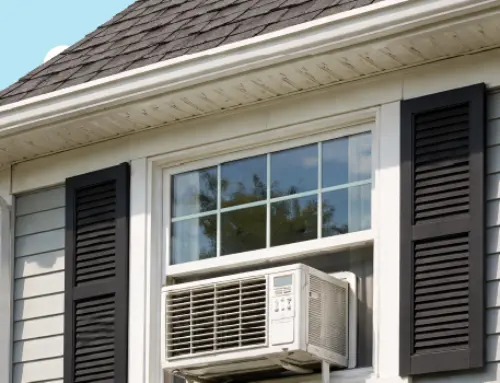How to Flush a Tankless Water Heater
by Tyler Castle
19.7 min read

Your tankless water heater might be called "low-maintenance," but that doesn't mean "no-maintenance." Over time, minerals like calcium and lime build up inside, clogging your unit's performance like plaque in an artery. And the result? Lukewarm showers, annoying error codes, and a machine that's silently begging for a spa day.
Flushing your tankless water heater isn't just a good idea—it's essential for keeping your system running efficiently, saving you money on energy bills, and extending the life of your investment. Not sure where to start? Don't worry; we've done our research, and we'll take you through the exact steps on how to flush your tankless water heater. Let's dive in!
Key Points of This Article:
-
Flush your tankless water heater once a year to keep it running efficiently and protect your warranty.
-
Professional flushing typically costs $160–$250, while a DIY flush can cost as little as $55 with basic supplies.
-
Tankless water heaters can last 20–30 years, nearly twice as long as traditional tank-style units.
-
Regular flushing prevents mineral buildup, which can reduce performance, cause damage, and even void your warranty if neglected.
Why You Need to Flush Your Tankless Water Heater
Over time, mineral deposits can build up inside the system, causing performance issues and even long-term damage. Here's why flushing your tankless water heater matters:
1. Prevent Mineral Buildup
According to experts at Green Building Advisor.com, minerals like calcium and magnesium can accumulate inside your tankless water heater over time, especially if you have hard water. This buildup can clog the system, reducing efficiency and potentially causing damage. Regular flushing removes these deposits, ensuring smooth operation.
2. Maintain Energy Efficiency
A clean heat exchanger in your tankless water heater allows your water heater to operate efficiently, heating water quickly without overexertion. When mineral deposits are present, the system must work harder, consuming more energy and resulting in higher utility bills.
3. Extend the Lifespan of the Unit
Routine maintenance, including flushing, can significantly extend the life of your tankless water heater. By preventing scale buildup and reducing strain on components, we've found you can avoid premature failures and costly replacements.
4. Ensure Consistent Hot Water Supply
Mineral buildup can lead to inconsistent water temperatures or reduced hot water flow. Flushing the system helps maintain a steady and reliable hot water supply throughout your home.
5. Protect Your Warranty
Many manufacturers require regular maintenance, including annual flushing, to keep the warranty valid. Neglecting this task could void your warranty, leaving you responsible for repair or replacement costs.
6. Reduces Repairs
Scale buildup doesn't just lower performance—it increases the chances of breakdowns. Over time, clogged heat exchangers and blocked flow sensors can cause error codes, shutdowns, or even water damage. Flushing helps you stay ahead of costly repairs.
7. Reduces Noises
Is your water heater starting to make popping or rumbling sounds? That's often a sign of mineral deposits interfering with water flow and heat transfer. Flushing the system clears out the debris, so your heater runs quietly and efficiently—just the way it should.
How Often Do You Need to Flush Tankless Water Heaters?
Regular maintenance is crucial to keep your tankless water heater operating efficiently and to extend its lifespan. Flushing the system helps remove mineral buildup, particularly in areas with hard water, which can impede performance and lead to potential damage.
If you're wondering how often to flush a tankless water heater, most manufacturers recommend doing it once a year to maintain optimal performance and comply with warranty requirements.
If you live in an area with hard water—water high in mineral content—you may need to flush your system more frequently, approximately every six to nine months, to prevent excessive scale buildup.
Signs Your Tankless Water Heater Needs Flushing
Not sure if your tankless water heater needs a flush? Your unit usually sends some clear signals—it's just a matter of knowing what to watch for. Here are the most common signs that it's time to give your water heater a good cleanout:
Your Hot Water Isn't as Hot: If your showers have gotten noticeably cooler or your water doesn't seem to heat up like it used to, there could be a layer of minerals inside the unit that's blocking proper heat transfer.
Water Pressure Seems Weaker: Have you noticed a drop in water flow, especially when using hot water? That could mean sediment is starting to clog up the heat exchanger or lines, making it harder for water to move through.
Your Energy Bills Are Creeping Up: When your water heater has to work harder to do its job—thanks to mineral buildup—it uses more energy. That strain can sneak its way onto your monthly bill.
You Can See White or Chalky Buildup: If you take a look at the unit and see crusty white residue or scale on the pipes or around the connections, that's calcium or lime buildup—and it's a surefire sign a flush is overdue.
It's Making Strange Noises: Hear popping, crackling, or rumbling from the unit? Those sounds usually happen when sediment has built up and is interfering with normal operation.
Your Hot Water Looks Murky or Rusty: Cloudy or discolored hot water—especially if it looks rusty—often means there's sediment floating around that needs to be flushed out.
Error Codes Are Popping Up: If your unit has a digital display and you're seeing error codes, check the manual. Some codes are designed to alert you when flushing or service is needed.
There's a Weird Smell Coming From the Hot Water: Funky or foul odors coming from your hot water? That could be bacteria forming inside the system, often due to sediment sitting too long.
You See Leaks Around the Unit: Leaks near your tankless heater might mean there's pressure buildup or internal damage caused by excessive scale inside.
The System Keeps Shutting Off: If your heater turns off randomly, it could be a safety shutoff triggered by overheating or restricted water flow from too much mineral buildup.
The Water is Scalding Hot All of a Sudden: If your hot water temperature is all over the place—or suddenly way too hot—it might be a sign that scale buildup is messing with the temperature controls or flow sensors.
Tools Required When Flushing a Tankless Water Heater
Whether you're gathering the items individually or using a flush kit, here's what you'll need to get the job done safely and effectively:
- Submersible Pump: A small utility pump (usually 1/6 to 1/8 HP) is essential for circulating the descaling solution through your water heater. This is the heart of the flushing process, pushing the solution in and out of the system to break down mineral buildup. This is often included in pre-made flush kits.
- Hoses: High-quality hoses—like washing machine hoses—are used to connect the pump and the tankless unit's service valves. One hose sends the solution in, and the other returns it to the bucket. Note that flush kits typically come with the right length and fittings.
- 5-Gallon Bucket: This bucket holds the descaling solution and serves as both the pump's reservoir and the return catch. It should be clean and chemical-safe. This is also part of most all-in-one kits.
- Descaling Solution: White distilled vinegar (about 4 gallons) is a natural and cost-effective choice. For faster or heavier cleaning, you can use a commercial-grade descaler like Flow-Aide or Calci-Free—just make sure it's safe for tankless systems.
- Adjustable Wrench or Channel Locks: You'll need this to loosen or tighten service valve connections and filter caps without damaging them. A must-have if any fittings are stuck or over-tightened.
- Rubber Gloves & Safety Glasses: Protect your hands and eyes when handling acidic descaling agents, even if you're using vinegar. Safety first.
- Towels or Rags: Leaks and drips can happen. Keep a few absorbent cloths nearby to wipe down any messes and keep your workspace dry.
- Timer or Stopwatch: Timing your flush helps ensure the solution runs for the recommended 45–60 minutes. This gives it time to dissolve mineral deposits effectively.
- Tankless Water Heater Flush Kit (Optional, but Recommended): If you don't want to source everything individually, you can purchase a flush kit that includes a compatible pump, hoses, and bucket—all designed to work together for this task. It's ideal for homeowners looking for convenience, especially if this is your first time flushing.
How to Flush a Tankless Water Heater
Flushing your tankless water heater may sound intimidating, but with the right tools and a little patience, it's a straightforward job. Here's how to do it properly:
Step 1: Turn Off Power and Shut Off Water Supply
Start by turning off the power—either at the circuit breaker for electric models or by switching the gas valve to the "off" or "pilot" position for gas units. Then, close all three water valves: the cold water valve (usually blue), the hot water valve (red), and the main service valve. This prevents water from flowing into or out of the system during the flush and helps you avoid leaks or pressure buildup.
Step 2: Relieve Pressure and Remove Purge Valve Caps
Before you connect anything, it's important to relieve pressure inside the system. Slowly unscrew the caps from the purge ports on both the cold and hot water valves. These ports will help you connect hoses for flushing. When flushing a tankless water heater, take extra care here—some pressure may release when removing the caps, so make sure the hot water valve is fully closed before removing these caps.
Step 3: Connect the Hoses
Next, attach a hose to each service valve—one on the cold water side and one on the hot. Place the ends of the hoses into a 5-gallon bucket to collect the flushing solution. If you're using a flush kit, connect the submersible pump to the hose on the cold water side, which will push the solution into the unit.
Step 4: Add the Descaling Solution
Pour about 4 gallons of undiluted white vinegar or a manufacturer-approved descaling solution into the bucket. This cleaning solution will circulate through the system to break down mineral deposits. One important rule when flushing a tankless water heater is to never use harsh chemical cleaners, as these can damage your unit and compromise your water quality.
Step 5: Open the Service (Purge) Valves
Now, open the purge valves by turning the T-shaped handles perpendicular to the hot and cold water valves. This step allows the vinegar to flow freely through the internal system.
Step 6: Circulate and Flush
Turn on your pump and let the vinegar circulate through the unit for at least 45 minutes. This gives the solution enough time to dissolve built-up scale and sediment. If you're not using a pump, gravity-based draining may take longer and be less effective.
Step 7: Drain and Rinse
Once the flush cycle is done, turn off the pump and close the purge valves. Carefully remove the hoses, discard the used vinegar, and reattach the purge caps. Don't overtighten the caps, as this can damage the rubber seals. Reopen the cold water valve briefly to let clean water flush through the system. A thorough rinse is essential when flushing a tankless water heater to make sure no residue is left behind.
Step 8: Restore Power and Water Flow
Finally, turn all three water valves—cold, hot, and main—back to the open position. Turn the power or gas supply back on. To finish, go to a nearby faucet and turn on the hot water slowly for about a minute. This releases any trapped air in the lines. With this last step, you've completed flushing a tankless water heater the right way—boosting your unit's efficiency and giving it a longer, healthier life.
Pro Tip: After flushing, check the area around the drain valve for any leaks. If something doesn't look or feel right, it's always smart to call a licensed plumber.
Flushing An Electric Tankless Water Heater
If you're using an electric model, the steps to flush a tankless water heater are slightly different but just as important. Here's how to safely and effectively flush your electric tankless unit at home:
Step 1: Preparation
To start, make sure it's safe to work by turning off the power at the circuit breaker. Close both the cold and hot water valves to stop any water from entering the unit. Open a few hot water faucets in your home to help drain any leftover water from the system.
Then, remove the access panel and use a non-contact voltage tester to confirm the power is completely off. Carefully detach the heating element and check it for any signs of damage. If it looks cracked or worn, it's best to replace it. Once removed, place the heating element inside the copper chamber—it'll get cleaned during the flush.
Step 2: Flushing
Pour undiluted white vinegar directly into the copper chamber and let it sit for two hours. This natural solution will break down mineral buildup and scale that affect performance. After two hours, drain out the vinegar completely. Reinstall the cleaned or replaced heating element and reconnect the wiring.
Step 3: Rinse & Restore
Now it's time to rinse the system. Open both the cold and hot water valves, and turn on a few hot water faucets for about five minutes. This helps flush out any leftover vinegar and pushes any trapped air out of the lines. Once the water runs clear and steady, turn the faucets off. This final rinse ensures that no cleaning solution is left behind that could affect water taste or quality.
Step 4: Final Cleanup
Finish up by removing the cold water inlet filter and giving it a good rinse in the sink to clear out any debris it has caught over time. Once clean, put it back in place. Close the access panel securely, then restore power at the breaker.
Flushing A Gas Tankless Water Heater
Gas tankless water heaters require a few extra steps due to their fuel source and combustion components, but the flushing process is still straightforward with the right tools. If you own a gas-powered model, here's how to flush a tankless water heater safely and effectively:
Step 1: Preparation
To begin, set the gas control valve to the pilot position or its lowest temperature setting. This keeps the unit safe while you work on it. Next, disconnect power to the unit completely. Remove the access panel and confirm there's no electricity flowing through the system by using a non-contact voltage tester.
Once power is confirmed off, shut off the gas valve along with both the cold and hot water valves. Then, carefully open the hot water pressure relief valve to drain out any remaining hot water from the system—be cautious, as it may still be very hot.
Now you're ready to set up the flush. Connect hoses to both the cold and hot water service ports. Place a submersible pump into a clean 5-gallon bucket, connecting the cold water hose to the pump. Drop the other end of the hot water hose back into the bucket so the solution can cycle through. Finally, pour about 4 gallons of undiluted white vinegar into the bucket. This will serve as your descaling solution during the flush.
Step 2: Flushing
With your setup in place, open both service ports and turn the pump on. Let the vinegar circulate through the heater for at least one full hour. This will break down any mineral buildup, especially in the heat exchanger. After the flushing cycle is complete, turn the pump off and discard the used vinegar.
Next, close the cold service port and disconnect its hose. Briefly open the cold water shutoff valve to flush any remaining vinegar out of the system. Allow the water to drain fully, then disconnect the hose from the hot service port as well. To complete this step, remove both the cold water inlet filter and the hot water filter. Rinse them thoroughly in a sink to remove any trapped debris or sediment.
Step 3: Cleanup & Restart
Once the filters are clean, reinstall them securely and reopen both the cold and hot shutoff valves to restore water flow. Reattach the access panel to the unit. Then, reopen the gas valve and turn the power back on to bring the unit back online. At this point, your gas tankless water heater is clean, flushed, and ready to operate at full efficiency.
How to Flush a Tankless Water Heater with Vinegar
Flushing your tankless water heater with white vinegar is a straightforward yet essential maintenance task to keep your system running efficiently. The process typically takes about 45 minutes to 1 hour. This duration allows the vinegar to effectively dissolve mineral deposits, such as calcium and scale, that accumulate inside the heat exchanger over time.
It is recommended to use 4 gallons of undiluted white vinegar for this procedure. The vinegar is circulated through the heater using a submersible pump, entering via the cold water service port and exiting through the hot water service port, creating a closed-loop system. This method ensures that the cleaning solution thoroughly contacts all internal components, effectively removing buildup without the need for harsh chemicals.
After the flushing cycle, it's important to rinse the system with clean water to remove any residual vinegar. This step helps prevent any lingering taste or odor in your hot water supply. Regularly performing this maintenance, typically once a year, can extend the lifespan of your tankless water heater and maintain optimal performance.
Always refer to your specific model's user manual for detailed instructions and safety precautions. If you're unsure about any step in the process, we recommend consulting with a professional plumber to ensure the task is completed safely and effectively.
Cost to Flush a Tankless Water Heater
Flushing your water heater is a key part of routine maintenance, and the cost can vary depending on several factors—such as the type of water heater you have, its size, where it's located, and whether you hire a professional or do it yourself. On average, homeowners in the U.S. spend around $160 – $250 to have a water heater flushed by a professional, but if you decide to handle the job yourself, it can cost as little as $55 for basic supplies like a flush kit and cleaning solution.
Tankless water heaters typically cost more to flush than traditional models. Because of their more complex design and susceptibility to mineral buildup, they often require more frequent maintenance. While the maintenance may be higher, tankless systems are more energy-efficient in the long run—saving you between 24% to 34% more energy compared to conventional water heaters, according to the U.S. Department of Energy.
If you're trying to estimate your own potential cost, household size and tank capacity are helpful indicators. Larger households usually require larger water heaters, which may lead to slightly higher flushing costs.
While flushing your tankless water heater yourself can save money, it's important to know what you're doing. Improper handling can damage internal components, cause leaks, or void your warranty. If you're unsure at any point—or just prefer peace of mind—hiring a licensed professional ensures the job is done safely, correctly, and without surprises.
How to Maintain a Tankless Water Heater
Maintaining your tankless water heater is essential to ensure it operates efficiently and lasts for years. Regular upkeep prevents issues like mineral buildup, reduced water flow, and unexpected breakdowns. Here's how to maintain your tankless water heater:
- Flush the System Annually: Over time, minerals can accumulate inside your water heater, especially if you have hard water. Flushing the system once a year with a descaling solution or white vinegar helps remove this buildup, ensuring optimal performance. Neglecting this can lead to decreased efficiency and potential damage to the unit.
- Clean the Water Inlet Filter: The water inlet filter traps debris and sediment before they enter the heater. It's advisable to check and clean this filter every few months. A clogged filter can restrict water flow and strain the system.
- Inspect and Clean the Air Intake Filter: For gas-powered units, the air intake filter ensures proper airflow for combustion. Dust and debris can accumulate over time, so it's important to inspect and clean this filter regularly to maintain efficient operation.
- Check the Venting System: Ensure that the venting system is free from obstructions and leaks. Proper ventilation is crucial for the safe operation of gas-powered tankless water heaters. Inspect the vent pipes periodically for any signs of wear or damage.
- Monitor for Error Codes: Modern tankless water heaters usually have digital displays that will show an error code when something's amiss. Familiarize yourself with these codes by consulting your user manual so you can address issues promptly.
FAQs
What is the Lifespan of a Tankless Water Heater?
Tankless water heaters are built for the long haul. On average, they can last 20 to 30 years, which is almost double the lifespan of traditional tank-style water heaters. Their longer life is largely due to having fewer parts that wear out over time and not constantly storing hot water. However, to hit that 30-year mark, regular maintenance like annual flushing is key. And while they do cost more upfront, many homeowners find the extra years of service—and the energy savings—well worth the investment.
Does Flushing Tankless Water Heater Void the Warranty?
Flushing your tankless water heater as recommended by the manufacturer is essential not only for maintaining its efficiency but also for preserving your warranty. Neglecting regular maintenance tasks—such as descaling or flushing—can lead to mineral buildup, which may damage the unit and potentially void the warranty. It's important to always follow the manufacturer's maintenance guidelines, including routine flushing, to keep your system protected.
Where Does the Water Go When Flushing a Tankless Water Heater?
When you flush a tankless water heater, the water doesn't just go down the drain—it follows a controlled loop. A small pump pushes vinegar or descaling solution into the heater through the cold water valve. The solution flows through the inside of the unit, breaking down any buildup, and then exits through the hot water valve. From there, it goes right back into the same bucket the pump is sitting in.
So during the flush, the liquid just circulates in a loop. After about an hour, you pour the used vinegar out—usually into a sink, floor drain, or toilet. When you rinse the system with clean water, that also drains into the bucket or wherever you've directed the hose. As long as everything is set up properly, the whole process is clean and easy to manage.
Flushing your tankless water heater isn't just a maintenance task—it's a smart move that protects your investment, boosts energy efficiency, and ensures reliable hot water for years to come. Whether you choose to DIY with the help of a flush kit or call in a professional, regular flushing helps prevent scale buildup, lowers energy bills, and extends the life of your unit.
Remember, a well-maintained system runs better, lasts longer, and keeps your warranty intact. So, make it a habit—flush at least once a year, keep those filters clean, and don't ignore the signs your heater is asking for attention.
Want to feel even more in control of your home energy? Pair proactive maintenance with an energy plan that offers consistency, clarity, and support. Explore Santanna Energy plans here and plan with confidence, no matter the season.
Tyler is an experienced energy professional, having worked for Santanna Energy Services, for the past four years. He is passionate about renewable energy and believes that diversifying the energy grid is the key to a sustainable future. Tyler is dedicated to supplying consumers with the best possible energy solutions and works diligently to make sure that Santanna can deliver the highest quality service.







